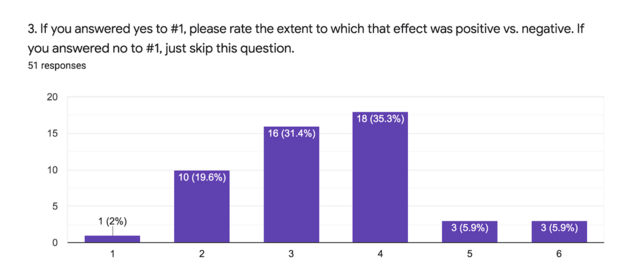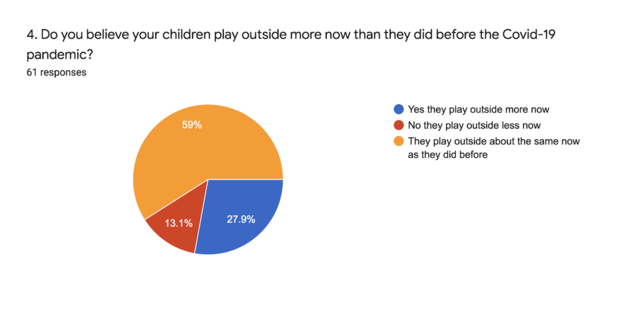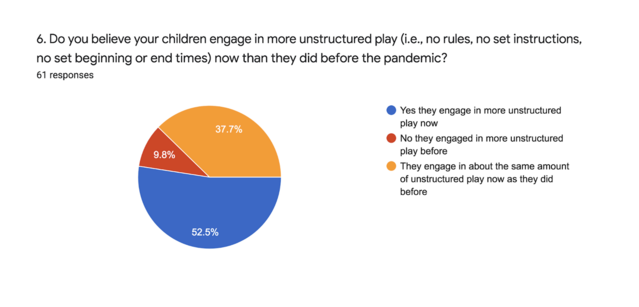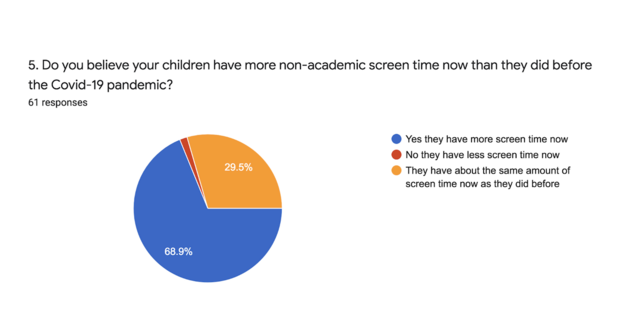Internet Addiction
How the Pandemic Continues to Impact Children's Play
Parents report kids' play has been affected directly and indirectly by COVID.
Posted July 27, 2021 Reviewed by Ekua Hagan
Key points
- A survey of parents of 2- to 12-year-olds revealed the pandemic has had mixed effects on children's play.
- The frequency of children's unstructured play and screen time has increased since the onset of the pandemic.
- Children's pretend play now reflects aspects of the pandemic, including masks, social distancing, and remote learning.
There is no doubt that the COVID-19 pandemic has impacted families and children around the globe in countless ways. The full extent of that impact may not be known for years to come. But as a parent of two young children, as a developmental psychologist, and as someone with an intense interest in play, I have been particularly interested in assessing how the pandemic has affected the play of children.
In particular, I have suspected — due to the need for social distancing, the decreased risk of outdoor activity, and the initial cancellation of many structured activities — that the pandemic has increased children’s outdoor play, increased the frequency of their unstructured/free play that is unbound by rules and increased their non-academically-based screen time.
Survey results regarding children's play
In order to test my hypotheses, in October 2020, I surveyed 67 parents of 79 children ages 3 to 10. In brief, I found from this survey that parents reported that their children played more outside both during quarantine and in the fall of 2020 than they did before the pandemic (see also this blog post), that they engaged in more unstructured, free play during quarantine and in the fall of 2020 than they did before the pandemic (see also this post), and that they spent more time in non-academic screen-based activities both during quarantine and in the fall of 2020 than they did before the pandemic (see also this post).
Follow-up survey
However, many schools have reopened and many structured activities such as organized sports and extracurricular activities and lessons have resumed since the fall of 2020. I therefore felt that it was necessary to conduct a follow-up survey to see if these results still held true 9 months later. I therefore recently surveyed another group of 61 parents of children (ages 2 to 12 this time) to determine their perspective on the effects of COVID-19 on the play of children as of July 2021. In total, the parents of the survey reported on 101 children: 9 2-year-olds, 3 3-year-olds, 12 4-year-olds, 4 5-year-olds, 10 6-year-olds, 10 7-year-olds, 16 8-year-olds, 8 9-year-olds, 21 10-year-olds, 5 11-year-olds, and 3 12-year-olds.
When asked about whether or not COVID-19 has impacted the play of their children, 82% (50 parents) said yes. Of those, 53% (27 parents) rated the overall impact of the pandemic on their children’s play as negative (3 or lower on a scale of 1 to 6), with the rest rating the impact as being primarily positive. The most popular response to the question about the extent of the impact on their children’s play was 4 (where 6 = very positive), with 35.3% (18 parents) choosing this rating, with a rating of 3 the next most common response (31.4%, or 16 parents).

When asked about their children’s outside play, 27.9% (17 parents) stated that their children play more outside now than they did before the pandemic, and 59% (36 parents) reported that their children play outside now about the same amount of time as they did before the pandemic. This suggests that while, initially, the existence of the pandemic may have encouraged higher levels of outdoor play, this has leveled off a bit as much of the country has reopened.

As for unstructured free play, 52.5% (32 parents) reported that their children engage in more free play now than they did before the pandemic, and 37.7% (23 parents) said that the amount of time that their children spend in free play is about the same now as it was before the pandemic. These results are fairly consistent with those from the earlier survey. Whether due to the cancellation of structured activities, parental reluctance to re-enroll children in potentially risky structured activities, or the discovery of the rewards and benefits of unstructured play, the levels of unstructured play have, for most families, increased since the onset of the pandemic.

When it comes to screen time, 68.9% (42 parents) admitted that their children spend more time in non-academic screen-based activities now than they did before the pandemic, and 29.5% (18 parents) said that screen time for their children is the same now as it was before the pandemic. Again, these results parallel those of the fall survey. For better or for worse, parents and children have become more reliant on screen time, perhaps as a substitute for some of those riskier structured activities, and/or as a way to socialize with friends and family whom they cannot see safely.

As a final question on the more recent survey, I asked parents to share any ways in which they have seen their children incorporate the effects of the pandemic into their pretend play. In response, they reported several fascinating anecdotes of how their children have responded to the pandemic through their pretense. For example, two parents of 3- and 4-year-old children reported that their children have pretended to give shots to themselves and to others “for the virus.” Another parent of a 4-year-old stated that her daughter “plays virus.” Similarly, two other parents of 2- and 4-year-old children also reported that their child more frequently play “doctor” and incorporate people being “sick” — sometimes with COVID — into their play.
Eight parents of a total of 16 children between the ages of 3 and 11 stated that their children have made masks for their stuffed animals, dolls, pets, and/or Barbies, and/or wear masks themselves when they play dress-up. Six children between the ages of 4 and 10 have incorporated masks, social distancing, quarantine, hand washing, and remote learning into their play (e.g., when they play “house” or “school”), according to their parents. Another parent described how her 4- and 6-year-old children have incorporated remote “meetings” — both for “work” and for “pleasure” into their play. Several parents reported that their children have begun drawing masks on figures in their artwork, and even drawing sanitizer.

It is clear that young children have been impacted by the pandemic, and this is being reflected in their play. These impacts can be seen both directly in how the children are pretending, and indirectly in how their unstructured play and screen time are increasing.
For the most part, while parents acknowledge that the pandemic has impacted their children’s play, most of them feel relatively neutral (or somewhat negative) about the effects. It is important to note that this survey represents a small sample of parents, the majority of whom are middle-class parents from the East Coast, and that the long-term impacts of COVID-19 on play remain to be seen. However, it is important to be aware that children often use play to communicate when they don’t have words. The social and emotional impacts of the pandemic on our children are real, and we need to continually monitor our children and their play.




